 The most challenging element to brewing this beer was the Black Invert Sugar. I poked around on the internet and found that you can create your own invert sugar using heat and acidity. Invert sugar is table sugar (succrose) which has been split apart into its two components, fructose and glucose. It tastes sweeter than table sugar, retains moisture better, and is less prone to crystallization. Hydrolysis (the addition of a water molecule) will cause succrose to break apart. In order to create our own invert sugar we catalyzed the hydrolysis reaction with heat and acid.
The most challenging element to brewing this beer was the Black Invert Sugar. I poked around on the internet and found that you can create your own invert sugar using heat and acidity. Invert sugar is table sugar (succrose) which has been split apart into its two components, fructose and glucose. It tastes sweeter than table sugar, retains moisture better, and is less prone to crystallization. Hydrolysis (the addition of a water molecule) will cause succrose to break apart. In order to create our own invert sugar we catalyzed the hydrolysis reaction with heat and acid.Invert Sugar Recipe
- 1 pound Table Sugar
- 1.5 cups water
- 1 tsp lemon juice
As we made the invert sugar we were also working on mashing and bringing the wort to a boil. The rest of the recipe was as follows (mostly copied from Barclay Perkins )
Christmas 2013 Porter (1923 Courage Stout)
5 Gallons
OG 1.044
FG 1.007

Grain
3 pounds Maris Otter
1.25 pounds Golden Promise
1.25 pounds Peark
0.75 pounds Black Malt
0.5 pounds Brown Malt
0.5 pounds Black Invert Sugar
Hops
17 IBUs Challenger at 90 minutes
12.2 IBUs Challenger at 30 minutes
Yeast: Yorkshire Ale, Ferment at 68 F
Primary for 2 weeks and then straight into a keg. Force carbonated to 1.8 Volumes of CO2.
Served at 55 F.
ABV 4.9% (Tested by Gas Chromotography)
Tasting Notes:
Beer pours full of tiny bubbles, looks just like a cask beer, strong tan head turns into a wonderful lacing around the glass. Jet black in color with no highlights.
Aromas of toast, coffee, chocolate, and a deep maltiness. No hop aroma, very well balanced.
Taste is smooth, chocolaty, and a little bitter roast bite at the finish. The beer is dry and has notes of coffee and toast. Roast increases as the beer warms.
Overall I am very pleased with this beer. It looks awesome coming out of the keg and it is a nice smooth drinker.
10/17/2014
I found a bottle of this beer in the basement. It was hidden in a box of bombers in the fridge and I stumbled upon it while looking for some old sour beers. I was pleasantly surprised to find the beer was still in great condition. Despite the low alcohol content everything tasted great. The coffee and chocolate flavors were a little subdued compared with the first tasting but the beer was still silky smooth.





















